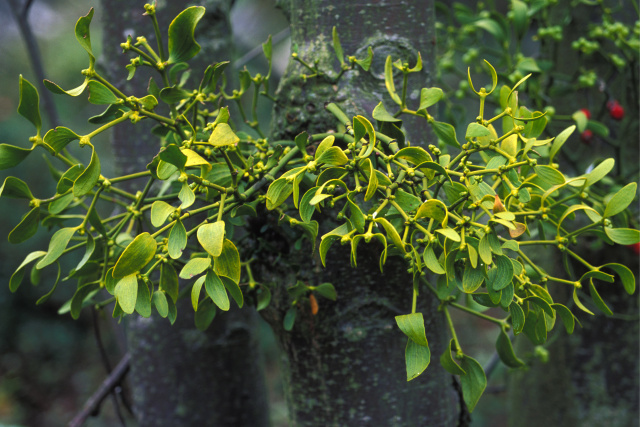
Common Names: European mistletoe, mistletoe
Background
- European mistletoe grows on several types of common trees such as apple, oak, pine, and elm trees. Where the term “mistletoe” is used in this fact sheet, it refers to European mistletoe. European mistletoe is different from American mistletoe, the type of mistletoe that grows in the United States and is used as a holiday decoration.
- Mistletoe has been used for centuries in traditional medicine for a variety of conditions including seizures, headaches, and arthritis. Today, mistletoe is used in Europe as a treatment for cancer.
- The berries, leaves, and stems of mistletoe are used to make extracts, which are usually given by injection under the skin. Mistletoe may also be taken orally (by mouth) as a dietary supplement. In Europe, mistletoe extracts that are given by injection are sold as prescription drugs. The U.S. Food and Drug Administration has not approved the use of mistletoe as a treatment for cancer or any other medical condition. In the United States, the use of injectable mistletoe extracts is permitted only in clinical trials.
How Much Do We Know?
- Although mistletoe has been studied for cancer, its effects are not well understood because much of the research on it has been of poor quality.
What Have We Learned?
- There have been clinical trials of mistletoe for cancer, mostly in Europe. Although some trials indicated that mistletoe improved survival or quality of life, almost all of the trials had major weaknesses that raise doubts about their findings. These weaknesses have included small numbers of patients, incomplete data, lack of information about the dose of mistletoe, and problems with the design of the studies.
- The National Center for Complementary and Integrative Health (NCCIH) and the National Cancer Institute have completed a preliminary trial to evaluate the safety of injected European mistletoe extract in combination with a cancer drug in patients with advanced cancer. It showed that patients could tolerate the herb/drug combination and provided other information that may be helpful in the design of future studies to evaluate mistletoe’s effectiveness.
- Mistletoe is not a proven cancer treatment. It should not be used outside of clinical trials.
What Do We Know About Safety?
- Mistletoe berries and leaves can cause serious harmful effects when taken orally.
- Injected mistletoe extract may cause soreness and inflammation at the injection site, headache, fever, and chills. Serious side effects are rare, but a few severe allergic reactions have been reported.
Keep in Mind
- Tell all your health care providers about any complementary or integrative health approaches you use. Give them a full picture of what you do to manage your health. This will help ensure coordinated and safe care.
For More Information
NCCIH Clearinghouse
The NCCIH Clearinghouse provides information on NCCIH and complementary and integrative health approaches, including publications and searches of Federal databases of scientific and medical literature. The Clearinghouse does not provide medical advice, treatment recommendations, or referrals to practitioners.
PubMed®
A service of the National Library of Medicine, PubMed® contains publication information and (in most cases) brief summaries of articles from scientific and medical journals. For guidance from NCCIH on using PubMed, see How To Find Information About Complementary Health Approaches on PubMed.
Office of Dietary Supplements (ODS), National Institutes of Health (NIH)
ODS seeks to strengthen knowledge and understanding of dietary supplements by evaluating scientific information, supporting research, sharing research results, and educating the public. Its resources include publications (such as Dietary Supplements: What You Need to Know), fact sheets on a variety of specific supplement ingredients and products (such as vitamin D and multivitamin/mineral supplements), and the PubMed Dietary Supplement Subset
Key References
- European mistletoe. Natural Medicines Web site. Accessed at naturalmedicines.therapeuticresearch.com/ on April 14, 2015. [Database subscription].
- Horneber M, Bueschel G, Huber R, et al. Mistletoe therapy in oncology. Cochrane Database of Systematic Reviews. 2008;(2):CD003297 [edited 2010].
- Mansky PJ, Wallerstedt DB, Sannes TS, et al. NCCAM/NCI Phase I study of mistletoe extract and gemcitabine in patients with advanced solid tumors. Evidence-Based Complementary and Alternative Medicine. 2013;2013:964592.
- National Cancer Institute. Mistletoe Extracts (PDQ). National Cancer Institute Web site. Accessed at http://www.cancer.gov/cancertopics/pdq/cam/mistletoe/patient on April 14, 2015.
This publication is not copyrighted and is in the public domain. Duplication is encouraged.

